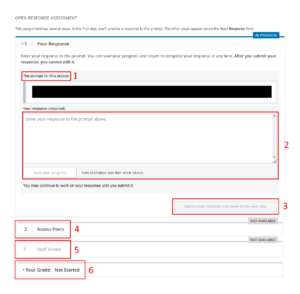Table of Contents
Open response assignments or ORAs are a special type of exercise in that they allow participants to grade each other and even themselves depending on how they are set up.
The different parts of an ORA: #

- Prompt: The prompt is the question or exercise the instructor wants you to complete. There could be more than one prompt.
- Response: The space for your response only allows plain text, although depending on the instructor’s setup you could also upload files and images. Be advice that you don’t have to submit your answer immediately, you can save your progress and come back later. Just remember to submit your response before the due date.
- Submit: Once you submit your response, there’s no going back, there’s no editing. That’s why you’re given the chance to save and come back later. When you’re comfortable with your response, you can submit and continue to the assessment step.
- Peer assessment: Here you will be asked to grade your fellow participants using a rubric set up by the instructor.
- Staff assessment: Here the course staff will evaluate your response based on the same rubric you used before.
- Your grade: Your final grade for this exercise will appear when all other participants required finish grading your response as well as the staff.

